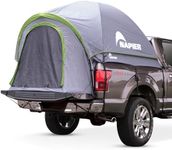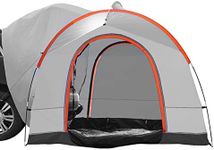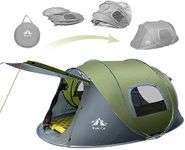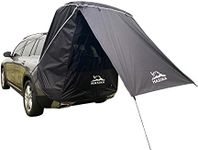Buying Guide for the Best Car Camping Tents
Choosing the right car camping tent is crucial for a comfortable and enjoyable outdoor experience. Car camping tents are designed to be more spacious and comfortable than backpacking tents, as they don't need to be as lightweight. When selecting a tent, consider the number of people who will be using it, the weather conditions you expect to encounter, and the features that will enhance your camping experience. Understanding the key specifications will help you make an informed decision and ensure that your tent meets your needs.CapacityCapacity refers to the number of people a tent can accommodate. It's important because it determines how much space you'll have inside the tent. Tents are usually labeled as 2-person, 4-person, 6-person, etc. However, these ratings can be snug, so if you want extra room for gear or prefer more space, consider sizing up. For example, a 4-person tent might be more comfortable for 2-3 people with gear. Think about how many people will be using the tent and whether you need extra space for comfort or storage.
SeasonalitySeasonality indicates the types of weather conditions a tent is designed to withstand. This is important because it affects the tent's durability and comfort in different climates. Tents are typically categorized as 3-season or 4-season. A 3-season tent is suitable for spring, summer, and fall, offering good ventilation and protection against rain. A 4-season tent is designed for harsher conditions, including snow and strong winds, but may have less ventilation. Choose based on the typical weather conditions you expect to encounter during your camping trips.
WeightWeight is the total mass of the tent when packed. While not as critical for car camping as for backpacking, it's still worth considering if you need to carry the tent a short distance from your car to the campsite. Tents can range from lightweight to heavy-duty. If you plan to camp close to your vehicle, weight may be less of a concern, allowing you to opt for a more spacious or feature-rich tent. However, if you anticipate needing to transport the tent over longer distances, a lighter option might be preferable.
Setup EaseSetup ease refers to how simple and quick it is to pitch the tent. This is important because it affects how much time and effort you'll spend setting up camp. Some tents come with color-coded poles and clips for straightforward assembly, while others might require more complex pole configurations. If you're new to camping or prefer a hassle-free experience, look for tents with a reputation for easy setup. Consider how often you'll be setting up the tent and whether you'll have help, as this can influence your choice.
VentilationVentilation is the tent's ability to allow airflow, which is crucial for comfort and reducing condensation inside the tent. Good ventilation is important to keep the interior cool in warm weather and to prevent moisture buildup. Tents with mesh panels, windows, and vents offer better airflow. If you plan to camp in warm or humid conditions, prioritize tents with excellent ventilation features. Conversely, if you're camping in cooler climates, ensure the tent can be sealed to retain warmth while still allowing some airflow.
Weather ResistanceWeather resistance refers to the tent's ability to protect against rain, wind, and other elements. This is crucial for staying dry and comfortable during inclement weather. Look for tents with a durable rainfly, sealed seams, and a robust frame to withstand wind. The tent's material and construction play a significant role in its weather resistance. If you expect to camp in areas with frequent rain or strong winds, prioritize tents with high weather resistance. For milder conditions, you might opt for a tent with less emphasis on weatherproofing.
Interior FeaturesInterior features include elements like storage pockets, gear lofts, and room dividers that enhance the tent's usability and comfort. These features are important for organizing your gear and maximizing space. Tents with multiple pockets and gear lofts help keep your belongings off the floor and within easy reach. Room dividers can provide privacy if you're sharing the tent with others. Consider what interior features are important to you based on how you plan to use the tent and the level of comfort and organization you desire.

















